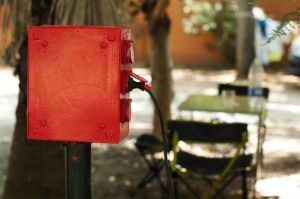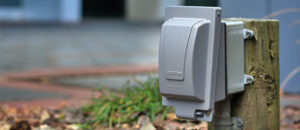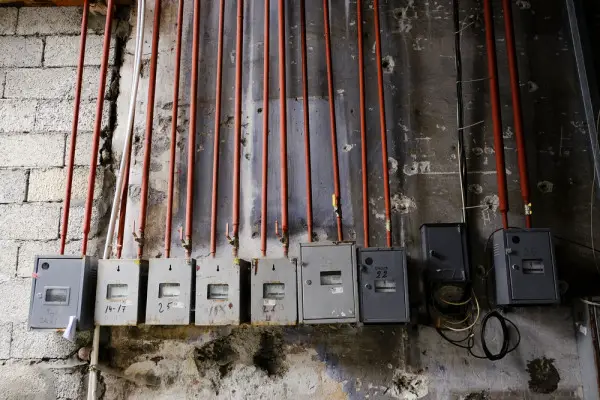Last updated on January 27th, 2022
Outdoor lights also serve for decorative purposes as much as they help to enhance your home’s security network. Unfortunately, varying weather conditions can create a hostile environment for the wire connections and plugs. What if it rains? How do you keep outdoor plugs dry? Learn in the post how to keep extension cord connections dry to protect outdoor electrical connections.
One of the simplest ways to protect outdoor plugs from wetness is by using plastic covers. These are typically known as “in-use” covers and help to create a 24-hour watertight seal around the plugs while they are in use.
There are other methods that also work for plug and outlet connections and plug to plug connections.
We will be discussing each one of these methods and hope that you’ll fully understand how to keep outdoor extension cords dry outside by the end of the article. This way, you can ensure the safety of your loved ones and reduce the risk of damaging your cords and appliances.
Table of Contents
How do you protect outdoor plugs from rain?
As earlier indicated, the simplest way to protect outdoor plugs from rain is to use a plastic box with an opening on the bottom.
Most outdoor outlets designed for homes usually come with spring covers or flippies. While closed, these covers are completely weatherproof. However, when a plug is inserted, everything becomes exposed to the weather.
To keep the plug and outlet dry, you will need an “in-use” cover.

Also referred to as a bubble cover, this lets you plug your cord into an outlet and close the cover. This way, both your outlet and plug are protected from the rain.
Without a doubt, this is the best way to keep your connections dry and ensure your safety.
Why keep plugs dry outside?
Water can get into a cord; as long as the cord is not plugged into an outlet, you can expect no harm or foul. Even the cord itself is safe and won’t get damaged. All you need to do is wait for it to dry, or you can dry it off with a towel to make things faster. Once the plug and cord dry, you can start using them again.
However, it’s an entirely different story when a wet plug or cord is connected to power. This can cause a short circuit.
Prevent Fire and Injuries
Fire is often the consequence of a short circuit. This usually occurs when someone unknowingly inserts a wet plug into an outlet. It could also be the outlet that is wet. Therefore, you should have the knowledge of how to protect outdoor extension cords outside.
To put off the fire, unplug the cord and douse it with flour or water. If you can’t access the plug because of the fire, use baking soda or a fire extinguisher (Class C).
Also, you can call 911, especially if the fire is much. Don’t wait till things get out of hand before you act.
Even if there’s no fire, there’s still a huge risk that someone will get injured or electrocuted. So make sure no one is close to the plug when you unplug it and allow it to dry.
Protect Your Lights and Appliances
Your outdoor space can be dull and not interesting if your outdoor lights are not working. You always want your lights to stay on or at least come on whenever you want them to.
Water causes short-circuiting, which in turn can cause a power outage, so keeping your outdoor plugs and outlets dry helps to prevent this from happening.
Besides shutting out your lamps, another reason you need to know how to keep outdoor extension cord dry to prevent short circuits, as it can also can also damage your appliances. This is the more reason you must protect your electrical connections against wetness.
How to keep plugs dry outside
So, how do you keep outdoor plugs dry? Well, here are some of the proven methods you can try out.
Using an Electrical Tape
One of the simplest ways to protect your outdoor connections from shock or damage is to wrap the area with electrical tape.
This works great for Christmas light plugs.
Just insert the plug into a GFCI (Ground Fault Circuit Interrupter) protected outlet or your regular outdoor outlet. Then carefully wrap the plug round with Teflon tape; make sure it’s tight and secure. I advise doing this several times to create a watertight seal.
For outlets with multiple receptacles, repeat the process for each receptacle and plug. Don’t leave any outlet or opening uncoated.
Using a Plastic Bag
If you don’t have Teflon tape or don’t want to use it for any reason, you can use a plastic bag or wrap to accomplish the same purpose.
Whether you’re using a plastic bag (e.g., a sandwich bag) or some other plastic wrap, you will still need tape to seal off the ends. A good duct tape or zip ties will do.
Make sure the coating is secure and truly sticks in order to create a complete seal that will keep moisture out.
Again, you should cover every receptacle and plug.
Install Covers under a Roof
For plugs that need to be connected to wall outlets, you can simply locate the outlets under a roof.
Ideally, this should be somewhere rain cannot directly reach, such as your screened-in patio or porch.
Also, you can install a cover over the receptacle to further protect it from moisture.
I strongly recommend using a cover for damp locations with a trap door that will protect the receptacle both when it’s empty and when something is plugged. Such covers usually have a trap door. However, the connection should only be left for a few days.
Use a Weatherproof Cover
When it comes to outdoor plug covers, there are two types you will find in the market that can help in keeping outdoor extension cords dry–those that are just “weatherproof” and those that are “weatherproof while in use.”
The normal weatherproof covers commonly feature a rubber gasket that is powered by a self-closing hinge. The hinge snaps whenever the cover is not in use.

In other words, the cover is only useful (weatherproof) when there’s no cord plugged in. But once you plug something in (when it’s in use), it offers no protection to the connection because then it’s open.
On the other hand, an “in-use” weatherproof cover offers protection to the plug and outlet. This type of cover usually has a semi-dome shape with a hole at the bottom where the plug is routed down.
With this type of cover, the door remains close while in use; this makes it hard for water or moisture to get in. To create an even tighter seal, you can caulk any gap between the wall and the cover.
I highly recommend using a GFCI outlet.
Use Dielectric Greases
Another option would be to apply dielectric grease on the connectors. This helps to repel water whenever it rains outside.
Just add some of the greases to the male connector before plugging it into the female connector. Repeat this a few times until a coat is formed on the connection.
Don’t worry; using dielectric grease is electrically safe.
Use Waterproof Sockets and Plugs
With any outdoor connection, it is best to use outlets and plugs that are specifically designed for outdoor use. Avoid using indoor sockets or plugs outside even if you are using an extension cord protector.
Either the plug or socket can be waterproof, but it’s better for both to be waterproof.
This is the first requirement before even considering additional protection such as a cover.
Make Your Own Cover
For plug to plug cord extensions near a sprinkler or wet surfaces, you will also need waterproof protection such as a plastic outdoor cord cover to keep the plugs dry. You can purchase extension cord covers online or from a local electrical store, or you can just make one yourself.
You will need stiff plastic containers for this project, which you may already have at home, or you can just buy new ones. Each container will serve as a “dry box” and will hold each cord connection. Your lunch meat container is a perfect example.
Simply drill holes on two sides of the container. This is where you fit in the extension cord, so make sure it’s big enough to receive the cord but not more so water doesn’t get in.
Now cut the holes using a utility knife. Go ahead and insert the plug. Replace the top of the container, and you’re good to go.
Though this won’t be an insanely watertight seal, it’s better than having nothing.
Precautions When Handling Plugs Outside
While it is important to know how to protect outdoor extension cords, it is a wise idea to take precautions when handling plugs outside. The following section outlines different safety measures when dealing with outdoor plugs.
- Use plugs with cords or wires that are not frayed or cracked. All worn-out cables should be thrown away and replaced. Don’t patch up with electrical tape; it’s not safe for outdoor use. Also, don’t connect plugs with bare cords. Before using any wire or cable, you can do a quick check by running it through your fingers to feel any cut or fray.
- Each outdoor cord should have its own dedicated sockets or outlet. Avoid plugging into outlets that are connected to other appliances or devices. Also, make sure the wattage on each extension cord is not exceeded.
- At no time should you ever try to modify an outdoor plug? For example, don’t clip off any prong or try to file it down just to make it fit into a different outlet.
- Minimize the use of extension cords, and try not to use them for too long. Never stretch or hyper-extend any cord beyond its length. Stretching can damage the cord or make it fray. It can also be a safety hazard with the potential risk of shock or fire if exposed to water.
- As earlier indicated, neither the outdoor plug nor outlet should be wet when connecting them. The same applies when connecting two cords; neither of them should be wet. Or else, you risk getting shocked or electrocuted, which can further result in a serious injury.
- Even after any one of the methods discussed above, extra care should be taken while handling the plugs whenever it rains. I personally recommend leaving everything until it dries before touching again.
Final Words
If you have stocked around till this point, then I’m sure you now know how to keep plugs dry outside. Again, to be on the safe side, use only plugs and extension cords that are designed for outdoor use.
Although such plugs do not guarantee complete protection from water, they have a better chance of survival than indoor plugs.
To further reinforce their water-resistant and make them completely waterproof, you can apply one of the methods above. This ensures you’re able to use your lights regardless of the weather condition. And more importantly, you will have peace of mind!
Frequently Asked Questions.
Can you leave an outdoor extension cord in the rain?
Unless it is in good condition and rated for outdoor use, it is not a wise idea to leave an outdoor extension cord in the rain.
Can you bury the outdoor extension cord?
No. Generally, it is not advisable to bury an outdoor extension cord. Although standard extension cords are made primarily for temporary use, you can buy a suitable cable to use for any permanent outdoor needs.
How long will an extension cord last outside?
While outdoor extension cords are specifically designed for outdoor applications, you should not leave them outside for more than two days. When you leave them for long, their materials start to break down and can lead to potential shock or fire.
Can you leave extension cords outside in winter?
Although extension cords made for outdoor purposes are strong, still they should not be left in winter for more than two days. Doing this can increase the potential of electric shock, sparkling, and fire.
Can an extension cord be submerged in water?
No. Do not dip extension cords in water. Even if it is indicated on the label as waterproof, submerging it into water can cause electrocution or an electrical fault at best.
How do I know if my extension cord is for outdoor usage?
You can if an extension cord is meant for outdoor usage if there is a letter W on the packaging material. Outdoor extension cords are built heavily and look tough with bright orange colours made from vinyl, rubber, or plastic.

